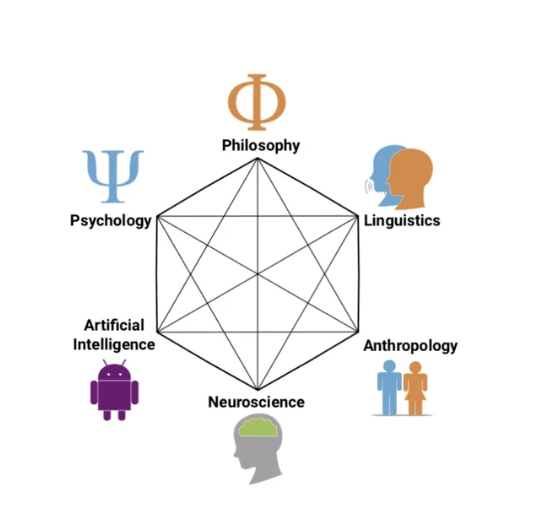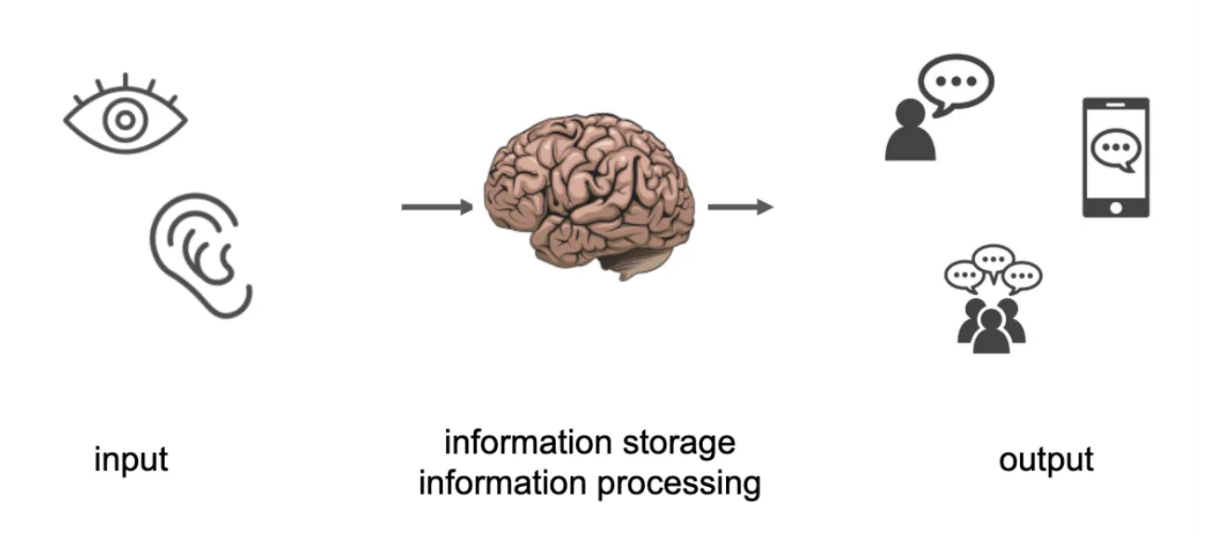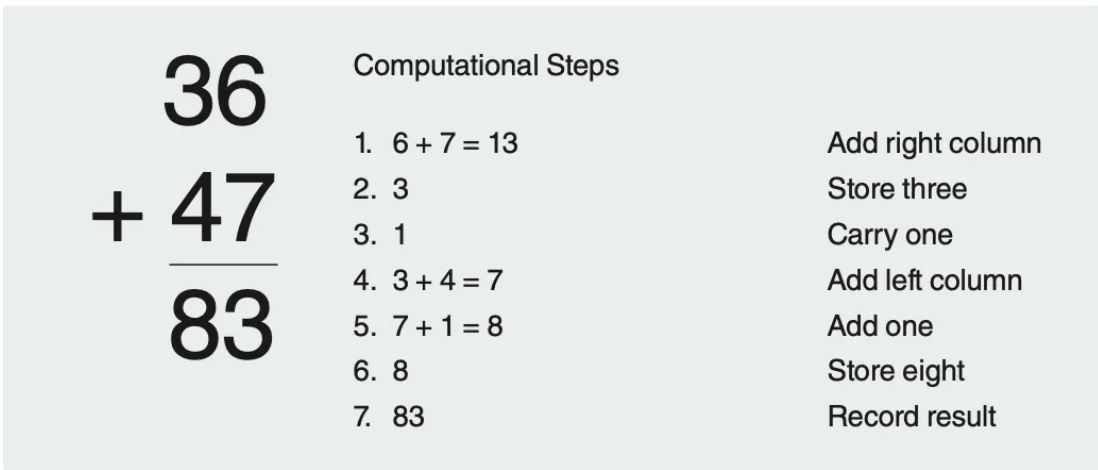Lecture 1: Introduction
1/20
Earn XP
Description and Tags
Ch. 1
Name | Mastery | Learn | Test | Matching | Spaced |
|---|
No study sessions yet.
21 Terms
Describe what a mental representation is
A mental representation is a mental construct that stands for or symbolizes something in the real world. It consists of a symbol that refers to a specific concept or object, known as its referent. These representations carry meaning (semantic content) and are typically intentional, meaning they are directed toward a specific object or idea.
Example: when you think about your parents, your thoughts are specifically focused on them, not on other objects. This shows that the mental representation is tied to the real-world referent (your parents).
A mental representation can trigger behavior related to its referent. For instance, seeing an apple (referent) triggers the mental representation of the apple, which might lead to a desire to eat it, followed by the action of eating it.
Describe what mental computation is
Mental computation refers to the cognitive processes the mind performs on mental representations. These processes act on or transform representations to produce outcomes such as decisions, problem-solving, or understanding.
Much like mathematical or syntactic operations, mental computations involve activities such as:
Sensation and perception (processing sensory input),
Attention (focusing on specific stimuli),
Memory (retrieving and organizing information),
Language (understanding and producing speech),
Logical reasoning, decision-making, and problem-solving.
These computations include general operations like scanning, matching, sorting, and retrieving information, allowing us to perform everyday cognitive tasks.
Define what interdisciplinary means
Interdisciplinary refers to an approach that integrates knowledge, methods, and insights from multiple academic disciplines or fields to address a topic, solve a problem, or understand a concept more comprehensively. This approach combines ideas from different areas, like psychology, sociology, biology, and more, to create a deeper understanding that cannot be achieved by focusing on a single discipline alone.
What is cognitive science? List five disciplines that participate in the field of cognitive science
Cognitive Science is the scientific interdisciplinary study of the mind
Cognitive Scientists view the mind as an information processor that represents and transforms information
psychology
philosophy
linguistics
anthropology
artificial intelligence

What 2 key aspects of the mind is cognitive science primairly concerned with understanding?
Representational Structures: These are the mental representations or internal symbols that the mind uses to store and process information about the world (e.g., images, ideas, concepts).
Computational Procedures: These refer to the mental processes or operations (like thinking, reasoning, problem-solving) that manipulate or act on those representations to produce thoughts, decisions, or behaviors.
In simpler terms, cognitive science focuses on how the mind represents information and how it processes or transforms it to understand and interact with the world.
Computer as a metaphor for the brain
The computer as a metaphor for the brain suggests that the brain processes information similarly to how a computer does. In this analogy:
Input: Information enters the brain through perception, such as what we see, hear, or sense from the environment (like data being entered into a computer).
Processing: The brain processes this information, storing it in memory and thinking about it (similar to how a computer processes data and stores it in memory).
Output: The brain then produces an output, such as language, behavior, or actions (like a computer generating a response or result).

What are the 4 types of representations?
Concepts: Represent a single entity or group of entities (e.g., words). They are basic ideas or categories we use to think and organize the world, like "dogs" or "freedom."
Propositions: Statements about the world that can be true or false. They express relationships between concepts (ex, "The sky is blue" or "2 + 2 = 4")
represent declarative knowledge → involves knowing facts, descriptions, or information that can be clearly articulated and tested for truthfulness
Rules: Specify relationships between propositions, often in the form of guidelines or instructions for behavior (ex. "If it rains, bring an umbrella").
represent procedural knowledge → Rules help direct actions by outlining steps or procedures for responding to situations, solving problems, or completing tasks.
Analogies: Helps us make connections between similar situations (ex. "The brain is like a computer"). Helps us generalize our learning by applying existing knowledge to new situations.
What are the 4 crucial parts of any representation?
Representation Bearer: The person or system that realizes the representation
Content: The information or meaning that a representation conveys, referring to what it represents in the real world → its referent (ex. a mental image of an apple includes its color, shape, and taste).
Grounding: The connection between the representation and its real-world referent, ensuring that it corresponds to something tangible (ex. the word "apple" stands for the actual fruit).
Interpreter: The person or system that understands or interprets the representation, giving it meaning
**representations are only useful if we can do smth with them → money in itself isn’t valuable, but through representation of knowing its value it becomes important
What is Marr’s three-level hypothesis? and what are the 3 aspects?
a three-level hypothesis for reasoning about complex systems (brain, computer, or human behavior)
used to evaluate biological or artificial information-processing events
3 aspects:
Computational
Algorithmic
Implementational
What is declarative and procedural knowledge?
Declarative knowledge refers to knowledge of facts or information about the world. It involves knowing what something is and can be expressed through verbal communication, such as stating that "Paris is the capital of France."
Procedural knowledge refers to knowledge of how to perform tasks or actions. It is skill-based, like knowing how to ride a bike, and is demonstrated through actions rather than words. This type of knowledge involves performing processes or tasks, often relying on the motor system.
Explain the computational level of Marr’s three-level hypothesis (2)
The computational level of Marr’s three-level hypothesis is the most abstract level of analysis, focused on understanding what problem a cognitive system is solving and why it needs to be solved. This level emphasizes two key tasks:
Problem Definition: The first step is to clearly define the problem by identifying its overall type (e.g., learning a function or estimating uncertainty) and breaking it down into its essential components. This provides a precise description of the problem, allowing it to be investigated using formal methods. It answers the question: What exactly is the problem?
Purpose and Adaptiveness: The second task is understanding the purpose or reason for the process. It asks, Why is this process necessary? In biological systems, this often relates to adaptiveness, meaning that mental processes have evolved or been learned to solve problems important for survival or functioning in the environment.
In essence, the computational level identifies what problem the system is addressing and why solving that problem is beneficial or adaptive for the organism.
Explain the algorithmic level of Marr’s three-level hypothesis
The algorithmic level of Marr's three-level hypothesis explains how a problem can be solved by outlining the specific steps or procedures used to process information. An algorithm is a formal procedure that acts on informational representations, specifying the exact steps needed to manipulate symbols and transform data.
Key aspects of the algorithmic level include:
Algorithms work on the form, not the meaning, of the symbols they manipulate.
are actions used to manipulate and change representations, outlining the specific steps needed to solve a problem
For example, think of a math problem. To solve it, you follow specific steps: adding, subtracting, multiplying, etc. These are the actions or steps that change the numbers (representations) to get the answer.
In the computer analogy, the algorithmic level is like the software that gives instructions for processing data, defining how a system performs a computation.
In simple terms, the algorithmic level shows the step-by-step instructions the system uses to take input (data) and process it to get the output (solution).

Explain the implementational level of Marr’s three-level hypothesis
The implementational level of Marr’s three-level hypothesis focuses on the physical substrate or "hardware" that performs the computation. It answers the question: What is the system made of? At this level, we examine the physical structures (e.g., neurons and synapses in the brain or transistors in a computer) that carry out the information processing.
In simple terms, it looks at the material components that enable the processing of information and how physical changes (such as electrical signals in neurons or circuits) support the algorithms and computations happening in the system.
What criticism does Marr’s three-level hypothesis receive?
being too simplistic as each of the levels interact with one another and can be further subdivided into own sublevels
What can the computer be viewed as?
a formal symbol manipulator
operates on symbols according to syntactic rules. A symbol is formal if it is governed by a set of rules (syntax), like grammar or math. These formal systems manipulate symbols based on rules, regardless of the symbols' meanings.
Syntax: Rules governing symbol systems.
Formal systems: Operate on representations without considering their meaning.
Computation: manipulate symbols according to a set of rules → these manipulations are physical actions that happen over time in a computing medium (neurons in the brain or circuits in a computer)
What is the physical symbol hypothesis?
The physical symbol system hypothesis suggests that any system capable of general intelligent action must be a physical symbol system. In this view:
Symbols are physical objects that can be combined into expressions (or symbol structures) to represent complex information.
Processes or operations can manipulate these symbols by following specific rules, allowing the system to generate new expressions, infer information, and solve problems.
What are arguments against the physical symbol hypothesis?
The symbol grounding problem:
Steven Harnad argues that symbols manipulated by computers (or any symbol-manipulating system) lack intrinsic meaning because they are not connected to the real-world objects, experiences, or environments they are supposed to represent.
Computing machines that are not embodied with sensors (e.g., cameras, microphones) and effectors (e.g., limbs) cannot acquire meaning.
What is a counter-argument to the symbol grounding problem?
computers ARE able to designate → link a symbol to its referent in a way that influences behavior or interaction
Ex. if a robot "designates" a coffee mug, it means the robot can recognize the symbol that refers to the mug and interact with the actual mug, like picking it up or manipulating it, based on its recognition.
How is representation and computation viewed?
Representation and computation are viewed differently across various schools of thought:
Classical Cognitive Science: Representations are fixed symbols, and information processing happens in a serial manner (step-by-step).
Connectionist View: Representations are distributed across networks, and processing is parallel, with multiple operations happening simultaneously.
Dynamical View: Representations are constantly changing, evolving with each new experience and environmental interaction.
What is a formal system made of?
A formal system consists of two key parts:
Symbols: Basic elements that can be combined to form expressions or structures representing information.
Processes (or Rules): These are operations that modify or act on the symbols and expressions, allowing new expressions to be formed.
An example of a formal system is formal logic, where symbols represent logical statements, and rules determine how to combine and manipulate them to reach conclusions.
Explain Information processing
Information processing refers to the way the mind or a system takes in, represents, and manipulates information. To process information, some aspect of the world must first be represented in the system.
A representation is a symbol that stands for something else.
The object or concept that a symbol refers to is called its referent.
The idea that symbols are “about” their referents is called intentionality.
In short, information processing involves using symbols to represent things in the world and applying operations to these symbols to perform tasks like reasoning, learning, or decision-making.